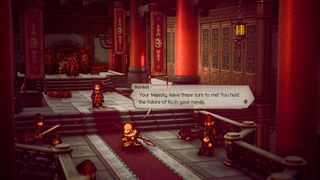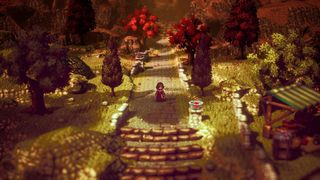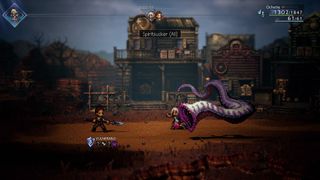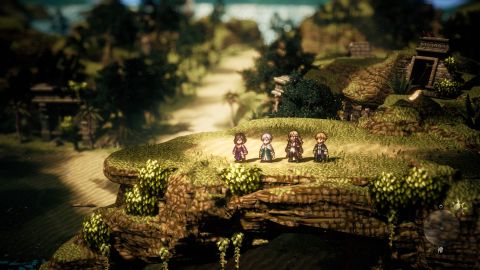Anyone who's been playing games for any length of time should be accustomed to the pull of nostalgia. Remakes, homages, and genre revivals are a cornerstone of the medium these days, and skilled developers know exactly which buttons to press to rekindle the warm glow of a more impressionable stage of life.

Release date: February 24, 2023
Platform(s): PS5, PS4, PC, Switch
Developer: In-house
Publisher: Square Enix
Octopath Traveler 2, like its predecessor, is a product of such skilled developers. It demonstrates a deep appreciation of '90s JRPGs, not least Final Fantasy 6, and extracts their essence to recreate what made fans fall in love with these games in the first place. For those of us of a certain vintage, it's a big steaming bowl of comfort food – just like mamma SquareSoft used to make.
The trouble with dealing in nostalgia, though, is that it's difficult to reconcile with the demands of the present. And for all the expertise on show in this sequel, it seems afraid to mature or escape the limitations of the first game. Like comfort food, as soothing as it is, it's unable to surprise, or challenge expectations.
Something old, something new

The artistry of the nostalgia on display here, though, really is a thing of beauty. More than most of today's pixel-art tributes, Octopath Traveler 2 recognises that Square and Enix's SNES JRPGs were AAA productions in their day, so simple retro revivals fail to capture that grandeur. In contrast, Octopath's pixel-textured 3D dioramas evoke the 16-bit age while offering a feast for modern eyes. Flat planes become pop-up picture books, their edges softened like wistful memories, dotted with warm smudges of lights and fireplaces. The effect is completed by haunting melodies and rousing battle anthems that could have featured in Final Fantasy 6 itself, had they been fed through a SNES sound chip.
Striding around the great outdoors and tackling dangerous creatures is handled with similar flair. The countryside is awash with blocky hills and model village views, plus a little more juicy to explore this time, thanks to the addition of waterways you can traverse on tiny boats to seek hidden treasures and alternate routes. Combat, meanwhile, is a mix of old-fashioned turn-based encounters and slick bombast, from the way characters swirl with lightning before unleashing powered up attacks, to the shattering glass sound effect when you break an enemy's guard, as if it's rewarding an act of vandalism.
That break mechanic, along with the 'Battle Points' (BP) that your combatants accrue over time, also ensure a level of tactical play. To whittle down your opponents' shields and score big hits you need to discover and then target their weaknesses to certain weapons or magic, diminishing their guard counter with each strike until you smash through, leaving them stunned and vulnerable for a turn. Your BP supplies can be used either to unleash multiple standard attacks or add oomph to special abilities. Ideally you want to save them until you've broken through then pile in at full power, but sometimes it's prudent to deploy them sooner, to break a guard quickly before your opponent attacks again.
This balancing act becomes delightfully taut against bosses – once again brilliantly depicted as towering tyrants that dwarf your diminutive charges. You may be racing against time to break them as they charge up a devastating strike of their own, and judging when to save or spend BP can be a matter of life or death. They're the proof that there's plenty of life in this traditional format yet, given some intelligent tinkering.
Pieces of eight

If you played Octopath the first, however, you already know all this, because it's simple recycling. Yes, there are a couple of fresh additions to the system: 'latent powers' build up as characters take damage until they can execute a unique skill – gaining an extra turn, say, or instantly filling their BP supply – while second jobs allow a character to add the skills of another to their repertoire, offering a little more party flexibility. But neither dramatically alter the flow.
And the same is true across the board, starting from the structure of your adventure, which once again focuses on eight travellers from different parts of the world, each with their own reason for hitting the road. Select one as your primary character, and you play through the opening chapter of their tale before setting off to pursue a far-flung goal. Before you get anywhere near it, though, you'll meet the other characters in their home towns, play their backstory chapters, then add them to your posse. Now you've got eight quests to see through, one chapter at a time, scattered across the map.
As before, then, you have plenty of freedom to decide on the order you recruit your gang and tick off their objectives. You're never constrained to a single location, and once you reach a new town you can hop back there as you see fit. This open invitation comes at the cost of a singular narrative line that pulls the group towards a common cause. Except for occasional side conversations and the addition of a handful of inconsequential mini-chapters in which two characters work together, each story focuses on a single individual, with the rest of the crew merely offering support in battle. The party dynamic so central to JRPG series from Dragon Quest to Persona is missing.

The pressure is thus on the stories themselves to be compelling, but only a few are, not least because the characters are a remix of the first game's cast, occupying the same range of professions – a warrior, a merchant, a cleric, and so on – and in many cases navigating similar scenarios. Some have causes that are easy to invest in – like the thief, Throné, fighting for her freedom from a life-time's slavery in a criminal gang – or compelling personalities, like the exuberant beast-girl hunter Ochette. But a few others are hard to care about or actually quite irritating, especially Partitio the entrepreneurial merchant.
Unfortunately, if you want to see the denouements of your favourite stories, you'll have to complete all the others as well, otherwise you'll never level up enough to survive later, tougher episodes. Indeed, the inflexible level recommendations that gate areas and chapters are something of a stumbling block once again in Octopath Traveler 2. After collecting my gang, I found myself substantially over-levelled for most of the second round of chapters, rendering them a dull slog, then unable to keep all my characters up to speed later on without committing to lengthy bouts of grinding.
Still, it's no surprise that Octopath Traveler 2 asks you to spend so much time churning through battles, because it doesn't really have anything else for you to do. Some effort has been made to vary the typical plot-dungeon-boss cycle in chapters, but that only serves to highlight how vapid the rest of the mechanics are. To progress in towns, you need to use characters' unique 'path actions', which enable them to interact with NPCs in various ways. And this time, each character has two rather than one, supposedly doubling the options at your disposal. Yet the new actions are all variations on old themes – acquiring items, gathering information, convincing the NPC to follow you, and knocking them unconscious – and involve simply walking up to a designated target and pressing a button.
Clerical Error

Perhaps the greatest weight around the game's neck, however, is that it's stubbornly traditional in the telling of its stories, seeming to lack a sense of awareness around how narrative design has evolved along with battle systems and visual styles over the last 30 years. While the appeal of '90s JRPGs was synonymous with child-eyed wonder, over time those eyes have become more discerning and sceptical, but the fiction here never gets beyond trite morality tales and hotchpotch fantasy confection.
The game's two continents, for instance, are filled with a grab bag of cultural touchstones gathered with scant concern for how they gel. Early modern European religious sensibilities are thrown in with an industrial revolution on the eastern landmass, while in the west a North American mining frontier somehow exists adjacent to a kingdom of samurai warlords. Like the stories themselves, these lands are autonomous units that lose coherence when combined. The American and Japanese side in particular feels like it's been painted in careless stereotypical strokes.
Tonally, the stories are equally haphazard. On the positive side, you can switch between lighter and darker stories as you see fit, but potentially heavy themes such as slavery and prostitution are thus sandwiched between, say, Agnea the dancer's quest for stardom, and any moral ambiguity falls by the wayside as each chapter wraps up neatly before the next. It's a shame because some of the themes here deserve serious treatment.

The game's cleric, for example, an inquisitor named Temenos, has the power to 'coerce' information out of NPCs if he can 'break' them in battle, which is, you know, shorthand for torture. Such behaviour could be the catalyst to explore his flaws, but Octopath Traveler 2 serves its party up as heroes working to defeat terribly villainous villains. The script is at fault here – it's adequate, but rarely poignant, profound, or funny – but more so is the fragmented, hurried plotting. Thrust into a murder investigation, the enigmatic Temenos quickly assumes a sympathetic role, where there's no room to interrogate how his methods might chafe against a noble aim.
In this way, the travellers' tales are not only bland by modern standards but lionise archetypes such as kind and just hereditary leaders, morally upstanding inquisitors and good capitalists. Added to the fact that Octopath Traveler 2 is a little too content to rest on its laurels, and it shows that while nostalgia can be a joyous experience, becoming too enraptured by the past can easily default to conservatism.
Octopath Traveller 2 was reviewed on PS5, with code provided by the publisher

